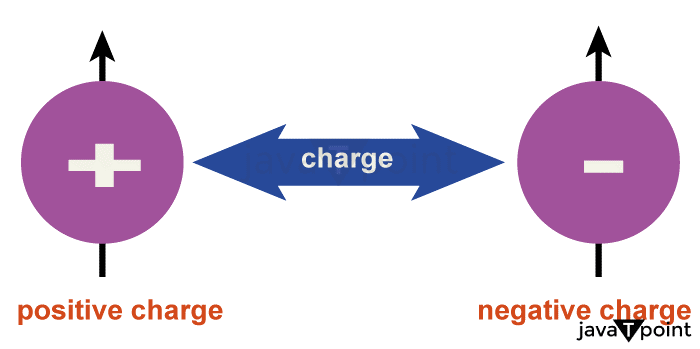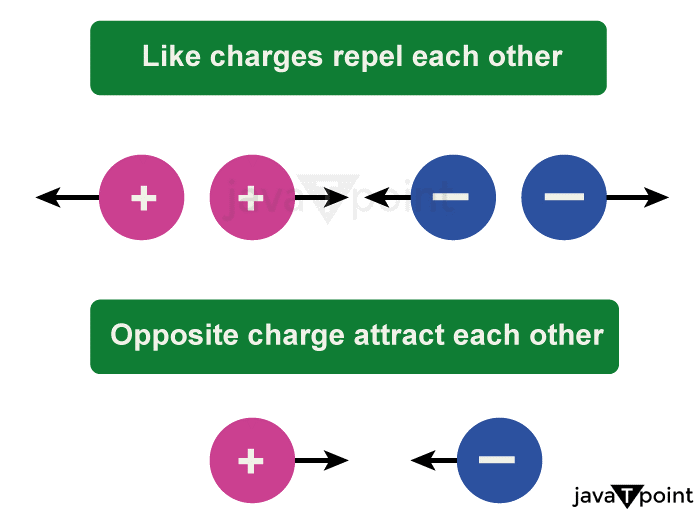Charge Definition PhysicsWhat Is Charge?A charge is a basic feature of matter that, according to physics, governs how particles interact. It is an electrical characteristic measured in units called Coulomb (C) and can be either positive or negative. 
A charge may be defined as an object's ability to attract or repel other charged items. A positively charged object, for instance, will draw another positively charged object away while repelling a negatively charged thing. Charges can move between things, resulting in an electric current, a movement of charged particles. It is possible to use this stream of charged particles to power various electrical gadgets. Charged objects and particles generate electric fields. These fields, responsible for the interactions between charged objects, may also be used productively in devices like electric motors. Origin of ChargeIn physics, the idea of charge has a lengthy and intricate history. The ancient Greeks, for example, were aware that some materials might attract or repel one another when they were rubbed together. Still, they needed a logical methodology to understand why this happened. It was in the 18th century that electric charges began to make sense. Charles-Augustin de Coulomb, a French scientist, tested the inverse square law of electrostatic attraction, which says that the force between two charged objects is inversely proportional to their square of the distance and proportionate to the product of their charges. Coulomb's experiments led to the development of electrostatics, which examines the behavior of resting charges. However, French scientist Charles-Augustin de Coulomb was one of the important players in the early understanding of electric charge. Coulomb's most well-known work pertains to electrostatics, which examines the conduct of static electric charges. In the late 18th century, Coulomb conducted several experiments to test the law of inverse squares of electrostatic attraction, which indicates that the force between two charged objects corresponds to the product of their charges and is inversely proportional to the square of the distance between them. The science of electrostatics was developed due to Coulomb's experiments, and it is still a vital area of study today. The Coulomb (C), a unit of electric charge in the International System of Units (SI), bears his name in honor of his contributions to physics. But physicists started comprehending the connection between electric charges and currents in the 19th century. Hans Christian Oersted, a Danish scientist who discovered in 1820 that a magnetic field could cause a nearby compass needle to be deflected, was one of the important pioneers in this breakthrough. This made it apparent that electric currents and vice versa produce magnetic fields. The electron, a subatomic particle with a negative charge, was discovered in the latter half of the nineteenth century. This was yet another important development. Due to this, the theory of electromagnetism, which combined magnetic and electric phenomena into a single framework, was developed. Our knowledge of charge today is based on the standard model of particle physics, which covers the behavior of basic particles, including electrons, protons, and neutrons. According to this theory, the interaction between particles and electric and magnetic fields is governed by a basic feature of particles known as electric charge. Particle physics research is still being done on the cause of this charge. Many physicists contributed to the evolution of electric charges over time. 
Roles of Charges in PhysicsMany branches of physics, such as electrostatics, electrodynamics, and quantum mechanics, depend critically on electric charges. These are some of the major functions that charges perform:
Charge's Nature and Characteristics
Basic Characteristics of ChargeThe underlying makeup of charge is a challenging subject that scientists are working to comprehend completely. However, according to what is known now, it is thought that subatomic particles like electrons and protons have charged as a characteristic. Protons are positively charged particles found inside an atom's nucleus, whereas electrons are negatively charged particles that circle the nucleus of an atom. A proton's and electron's charges have the same magnitude but different signs. Also found inside the nucleus are neutrons, which have no charge. Scientists are currently investigating the precise nature of the charge, but they have put out several proposals to explain its fundamental makeup. According to one hypothesis, charge results through the interchange of virtual photons, which are electromagnetic force carriers. It is also possible that a field that penetrates the entire universe and interacts with charged particles has the attribute of charge. By considering mathematical equations and models, the behavior of charge may be defined and predicted regardless of its precise composition, and the same can be used to process further for usage. A charge is vital to our comprehension of the natural world and is key to various scientific processes, such as electricity, magnetism, and electrochemistry. Behavioral Aspects of ChargeOne of matter's basic properties, electric charge, is essential to many physical events. This part will examine how charge behaves in various situations and states.
Generation of ChargeWe have to understand the structure of atoms to comprehend how the charge is produced. Atoms are made up of protons, neutrons, and electrons. Protons have a positive charge, neutrons have no charge, and electrons have a negative charge. The protons and neutrons are in the atom's nucleus, and the electrons orbit around it. An atom becomes charged when one or more electrons are added or removed. For instance, if an atom adds one electron, it changes its charge since it now has more electrons than protons and is thus negatively charged. One atom becomes positively charged if one electron is lost because it has fewer electrons than protons. A substance may interact with other charged things once it has a net charge. While opposing charges attract one another like charges repel one another. This interaction is governed by Coulomb's law, which states that the force between two charged objects is inversely proportional to their separation and proportionate to the product of their charges. Charged particles in motion can produce electric currents. The movement of charged particles through a medium, such as electrons, is an electric current. A voltage differential between two places in a circuit might cause this charge flow. Voltage, produced by the movement of charge, measures the electric potential energy per unit charge. Magnetic fields also have an impact on the mobility of charged particles. A force perpendicular to the magnetic field and the charged particle's velocity is experienced when the charged particle travels through a magnetic field. The Lorentz force law, which says that a charged particle experiences a force proportionate to its charge, velocity, and magnetic field strength, describes this force. ConclusionA key part of many physical processes is played by the basic feature of matter known as electric charge. It can be positive or negative and is produced by the motion of charged particles. According to Coulomb's law, opposing charges attract one another while like charges repel one another. The rules of electromagnetism, which explain the interplay between electric and magnetic fields, control the behavior of charged particles in motion. An electric current, the movement of charged particles through a medium, can be produced when charged particles are in motion. Numerous branches of science and technology, such as electronics, electromagnetism, plasma physics, and quantum mechanics, all depend on our knowledge of electric charge.
Next TopicCircumference Definition
|
 For Videos Join Our Youtube Channel: Join Now
For Videos Join Our Youtube Channel: Join Now
Feedback
- Send your Feedback to [email protected]
Help Others, Please Share










